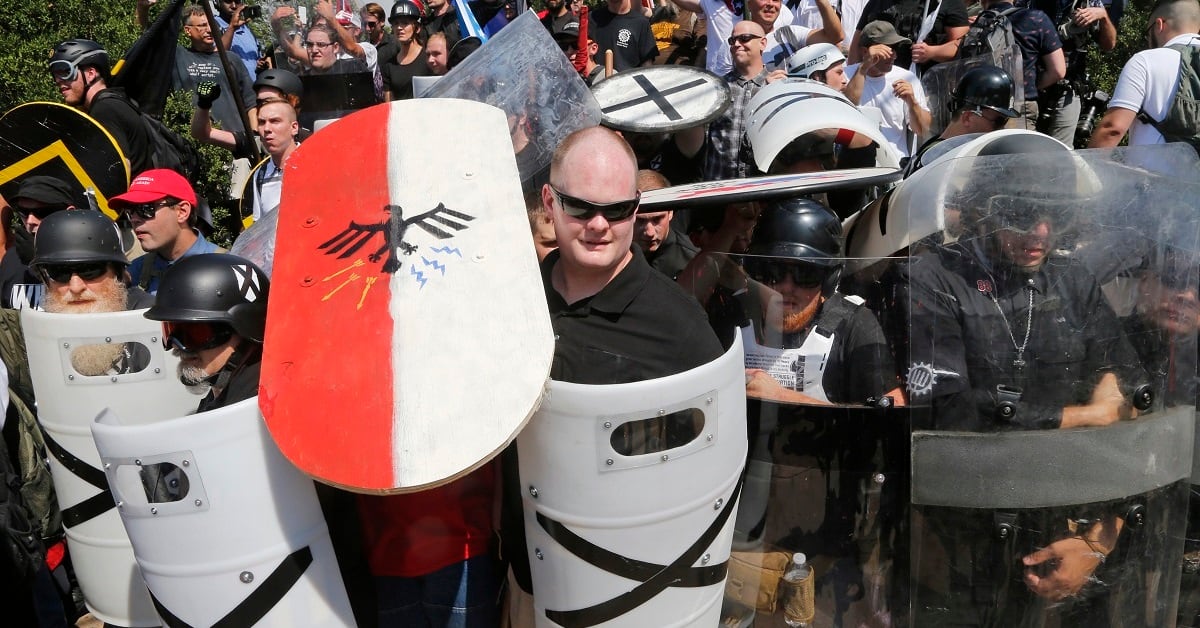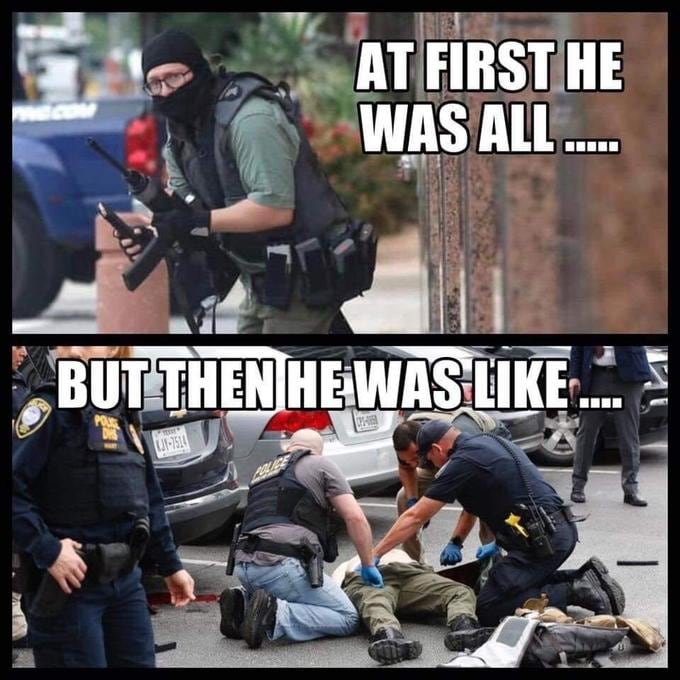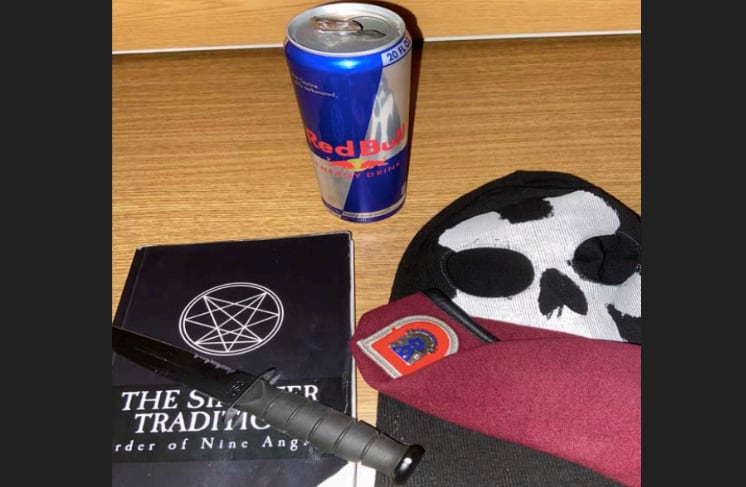As protesters have taken to the streets this month to call for racial justice and police reform, in the wake of the alleged murder of George Floyd by Minneapolis police, another movement has made headlines for all the wrong reasons. Its name is Boogaloo.
Two weeks after the FBI arrested an Army reservist and two veterans, one of the Navy and the other the Air Force, for planning to incite violence at a Las Vegas protest, an active-duty airman shot and killed a federal security officer in Oakland, California.
All four, according to their online activity, identified with the far-right group, which is loosely tied to anti-government and white-supremacist beliefs, but mostly advocates for an armed insurrection― of whatever kind― in general.
RELATED

Though largely brushed off by veterans and service members as a group of has-beens and wannabes, the Boogaloo archetype that emerged in memes in the past decade has taken hold in the violent-extremist corners of the internet.

In both the white-power and anti-government “communities, ‘boogaloo’ was frequently associated with racist violence and, in many cases, was an explicit call for race war,” according to the Southern Poverty Law Center. “Today the term is regularly deployed by white nationalists and neo-Nazis who want to see society descend into chaos so that they can come to power and build a new fascist state.”
But the movement, as it were, is still disparate and diffuse. And it’s one of several quasi-groups that have sparked investigations in the military.
Late last year, the Army launched an investigation into a Fort Benning, Georgia-based mid-grade officer who had been spouting racist, anti-government rants on Reddit, calling for the same type of armed insurrection sought by so many extremist groups.
RELATED

Known as Nebor, Maj. Jeff Poole was a fixture on the Army subreddit, where a group of moderators noticed his activity on other subreddits and used his information to compile a 75-page report for Army Criminal Investigative Command on his activity.
Poole did not appear to associate with any organized group, unlike Army Pvt. Ethan Melzer, who was indicted this month in a plot to attack his own unit, spearheaded by a Europe-based “Satanist neo-Nazi group.” originally founded in the United Kingdom.
Members of the Order of the Nine Angles have “espoused violent, neo-Nazi, anti-Semitic, and Satanic beliefs, and have expressed admiration for both Nazis, such as Adolf Hitler, and Islamic jihadists, such as [Osama] Bin Laden, the now-deceased former leader of al-Qaida,” his indictment reads.
RELATED

And in 2018, the Marine Corps discovered then-Pvt. Vasillios Pistolis had joined the Atomwaffen Division, a neo-Nazi group founded in 2015 by Brandon Russell, who enlisted in the Florida Army National Guard the following year.
“The challenge is, it’s a huge melting pot of different individuals without a clear-cut ideology,” Seth Jones, a researcher at the Center for Strategic and International Studies, told Military Times in a Monday phone interview. ”People are associating with it that have different short- and long-term objectives. And that’s the problem for those of us that write about it.”
Jones and two co-authors released a report June 17, “The Escalating Terrorism Problem in the United States,” the result of a compilation of data that includes far-right, far-left, religious and other extremist groups.
“Based on a CSIS data set of terrorist incidents, the most significant threat likely comes from white supremacists, though anarchists and religious extremists inspired by the Islamic State and al-Qaida could present a potential threat as well,” they found.
The problem with building strategy from that data is that, unlike the decades of orqanized groups, writings and vaunted leaders under the jihadist movement, the ideology and goals of both far-left and far-right groups in the U.S. are somewhat all over the place.
Some associates are “against government, at least as it exists at the moment,” Jones said of the far-right end. Others are more aggrieved by what they see as overreach from the most liberal end of the political spectrum.
Some are outright white supremacist, or at least anti-immigration. Some are anti-police or explicitly anti-Black Lives Matter, while others have tasked themselves with protecting local businesses from rioting in the wake of of Floyd’s killing.
“I suppose if we had a Zoom call after this, if we had 10 different people who associated themselves with the Boogaloo movement, and we asked them the same question ― we asked them their objectives, what their goals are, what they want the United States to become ― you’d get 10 different answers,” Jones said.
The military connection
As for whether or why those ideas appeal to service members or veterans, at least compared to the general public or to other professional backgrounds, Jones was not ready to make a determination.
“Veterans do pose a potential threat if and when they radicalize, because they oftentimes have access to ― whether it’s weapons, or particularly the know-how to use them,” including firearms and improvised explosive devices, he said.
RELATED

He offered Timothy McVeigh, an Army veteran and the 1994 Oklahoma City bomber, as one example. Maj. Nidal Hasan, the jihadist Army psychiatrist who massacred troops and civilians at Fort Hood, Texas, in 2009, is another.
But the first step in determining whether the military has a problem with the extremist right would be to study it, he added. As a former researcher at Rand Corp., he said, he partnered with the Defense Department to study sexual harassment in the same way.
“I do think the first question is, how serious is the problem?” he said. “I’m not aware off the top of my head that anyone has run data to note this.”
Following multiple hearings on the issue, Congress has made a move: proposing in the latest House version of the 2021 National Defense Authorization Act bill that DoD start tracking and reporting white supremacist activity in the military, in addition to other extremist behavior or criminal gang affiliations.
RELATED

It would require a central database of investigations, as well as criminal and administrative actions, and the results of each.
DoD would also have to submit that data to both the House and Senate armed services committees at the end of each year.
Lawmakers called it an important step in gauging the problem in the ranks, but similar language in the legislation last year failed to survive congressional negotiations.
“We need that data,” Heidi Beirich, chief strategy officer for the Global Project Against Hate and Extremism, said at a February hearing. “The Military Times poll has become a stand-in for that. But the military needs to be collecting it.”
Meghann Myers is the Pentagon bureau chief at Military Times. She covers operations, policy, personnel, leadership and other issues affecting service members.




